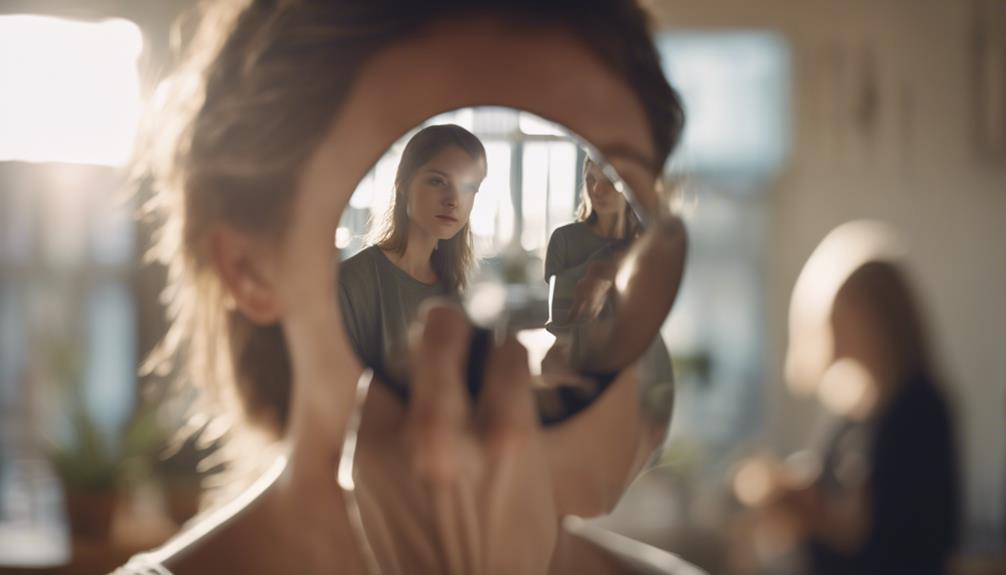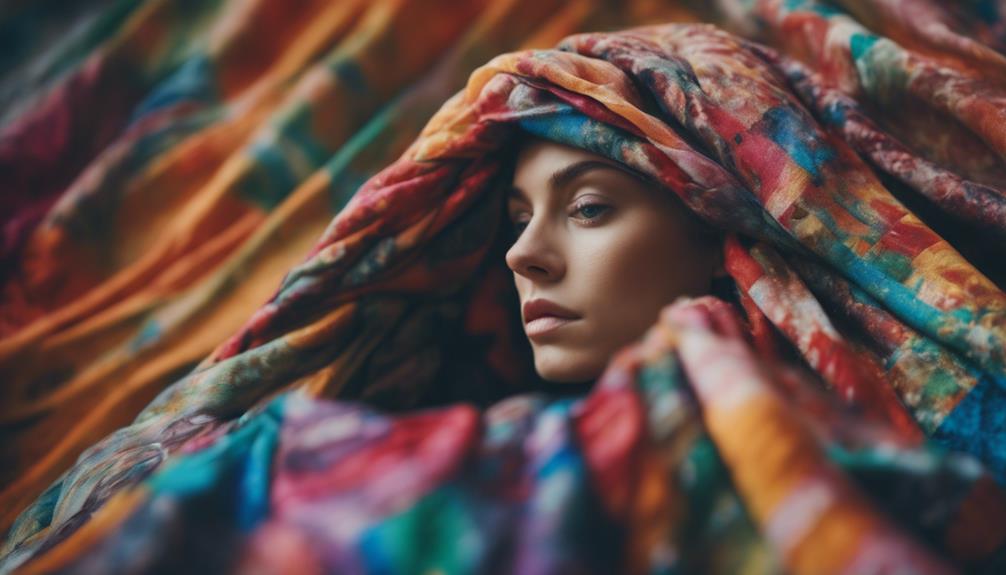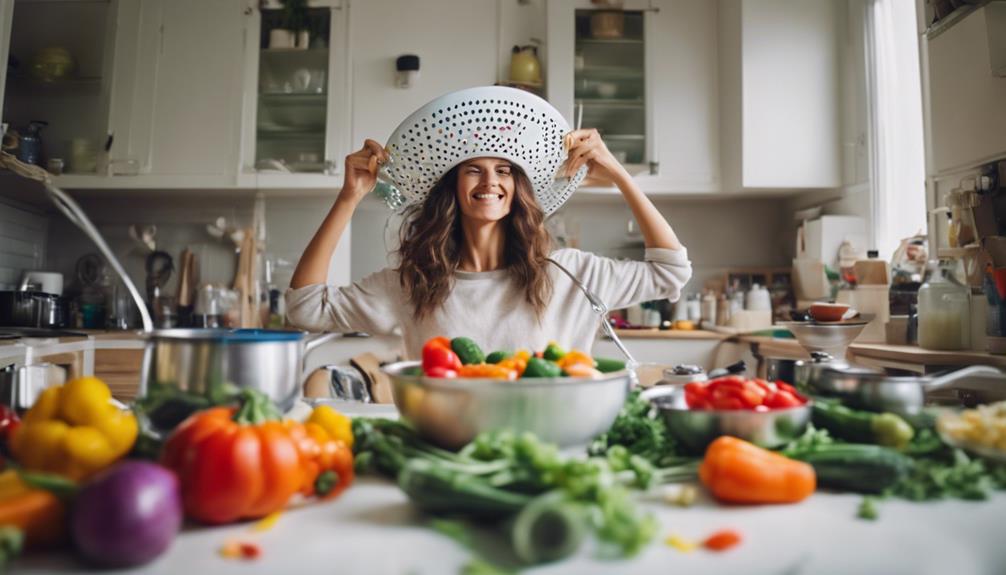Transform your home into a studio with nothing but everyday objects! Grab a mirror to expose light, casting enigmatic patterns around you. Drape colorful fabrics for a burst of vibrancy, or play with shadows using simple cutouts to outline dramatic silhouettes. Why not scavenge the kitchen? A colander can create a polka-dot universe, and fruits could color your scene with surreal colors. Anything, from glasses to kitchen foil, becomes part of your canvas, refracting or softening the light artistically. Each item in your house holds a secret waiting for you to reveal—can you tease out their potential to craft stunning portraits?
Harnessing Light With Mirrors

Why not transform your space into a dynamic studio by manipulating reflections with mirrors? Imagine mirrors as your canvas and the light as your brush. You've got a simple mirror, right? Angle it, play with it. Each tilt sends light skating across surfaces in new, unpredictable patterns. It's not just reflection; it's refraction, redirection, a whole dance of brightness at your fingertips.
Think of your room's natural light as an ally. Where does it hit hardest? That's your starting point. Now, introduce your mirror. Angle it towards that puddle of light. Watch as the light bends, breaking into beams that kiss the walls, the ceiling—maybe even you. You're painting with light, using mirror reflections as your strokes.
Now, tweak the scene with angled lighting. Bring in a lamp, adjust its neck. The artificial light meets the natural, they tangle, they play off each other, and your mirror? It's the conductor. Shadows might want to creep in, but you're focused on the brilliance, the way mirrored light can sculpt your face, your space, in ways you've never seen. Just by shifting angles, you shift the entire mood. Isn't that a power you'd love to harness?
Crafting Silhouettes With Shadows
Now, let's explore how shadows can shape striking silhouettes, crafting contrasts that define yet defy, capturing the essence of mystery in your visual storytelling. You'll find that shadow positioning isn't just about where the light falls, but where the dark encroaches, creating edges that tell tales without a single word whispered.
Dive into silhouette experimentation by transforming mundane objects into ethereal figures. Imagine a teapot morphing into an elephant, its spout a graceful trunk. With the right angle and a playful twist of light, what's real blurs with what's imagined. You're not just taking a photo; you're sketching dreams onto the canvas of reality.
Shift your perspective—literally. Crouch low, aiming your lens up where shadows loom larger than their subjects. See how dramatically different the story reads when told from the ground looking up? It's about challenging perceptions, breaking the rules of conventional portrait photography.
Innovative Uses of Colorful Fabrics

Immerse yourself in the vibrant dance of colorful fabrics, exploring the mundane and turning it into a spectacle of light and shadow. As you explore the world of creative photography, let the bold hues and intricate patterned backdrops become your playground. Fabric textures whisper tales of depth and dimension, each fold catching the light differently, creating a dynamic tableau before your lens.
Experiment with the juxtaposition of rough and silky materials. Imagine a portrait where coarse burlap meets smooth satin—each texture telling its own story, enhancing the emotional depth of your composition. You'll find that these fabric backdrops can serve more than a mere background; they become an integral part of the narrative you're crafting through your images.
Don't shy away from playing with lighting to see how it interacts with your fabrics. A sharp side light can accentuate the peaks and valleys in a textured cloth, while a softer light might highlight the subtle gradations of color in a gradient fabric. Use these elements to your advantage to create an atmosphere that pulls viewers into the scene, compelling them to linger over the complexities you've captured.
Creative Effects With Household Glass
Venture beyond fabric and explore the luminous possibilities of household glass, transforming everyday vistas into extraordinary visual poetry. You'll find that your ordinary glass items aren't just for gazing through or sipping from—they're gateways to a world of visual wonder.
Start with glass refraction techniques. Place a simple drinking glass or a crystal vase between your camera and your subject. Watch as the light bends, splits, and dances, casting an array of patterns that seem to whisper secrets of a hidden domain. Each twist and turn of the glass shapes the light uniquely, creating surreal, dream-like portraits that captivate the imagination.
Next, experiment with textured glass backgrounds. That old, patterned glass window in your attic? It's not just a barrier against the elements; it's a canvas waiting for your creativity. Position your subject behind the textured glass and shoot. The glass distorts and softens the features, adding a layer of mystery and depth to your portraits. It's like painting with light and shadow, each ripple in the glass adding a stroke of unexpected beauty.
These methods aren't just techniques; they're invitations to see the world—and your art—in a new light.
Dynamic Shots With Kitchen Items

Exploring your kitchen, you'll discover that utensils and appliances aren't just tools for cooking but instruments for crafting dynamic, visually intriguing portraits. Imagine using the humble spoon, not for stirring, but for creating mesmerizing reflections. Place it strategically in front of your lens, and it bends reality, distorting features and surroundings into surreal tableaus. You're not just capturing a face; you're sculpting light and shadow into fantastical shapes.
Now, consider the vibrant potential of fruit filters. Slice an orange, lemon, or lime thinly enough to let light pass through and hold it up to your camera. The fruit's texture and color filter the light, casting dappled, tinted patterns across your subject's face. Each piece of fruit adds a unique hue and mood, transforming ordinary light into an artist's palette of warm yellows, zesty oranges, or cool greens. It's not just a portrait—it's an orchard of expression, ripe with possibility.
Through these everyday items, you're not just taking pictures; you're weaving stories and painting with pixels. The kitchen, your studio; utensils, your brushes; every shot, a masterpiece waiting to be discovered. Embrace this culinary canvas, where creativity knows no bounds.
Portraits With Paper Cutouts
Stepping beyond the kitchen, you can wield simple paper cutouts to cast enchanting shadows and shapes, adding layers of narrative and intrigue to your portraits. Imagine transforming a plain backdrop into a storytelling canvas with nothing but the playful interplay of light and paper. You're not just taking a photo; you're sculpting an image, crafting scenes as whimsical or profound as your creativity allows.
Experiment with paper textures—perhaps the roughness of recycled paper gives your image a gritty feel, or the smoothness of vellum adds a ghostly aura. The scale of your cutouts also dramatically alters the mood; large, looming shapes can evoke a sense of foreboding, while smaller, intricate designs might create an atmosphere of delicate wonder.
Position your cutouts between the light source and your subject. As you shift the paper, watch as the shadows morph, dance, and redefine the features of your model. It's like painting with shadow—each tiny adjustment a stroke of your unseen brush.
You'll find that these paper silhouettes can do more than decorate—they can also define. They can whisper secrets about your subject, frame their emotions, and echo their essence. Engage with this simple tool, and let your photographic stories unfold.
Frequently Asked Questions
What Camera Settings Are Best for Indoor Object-Based Portrait Photography?
For your indoor object-based portrait photography, you'll want to explore lens choice and focus techniques. Experiment with a wide aperture to isolate your subject, creating a dreamy, blurred background that makes your object stand out. Immerse yourself in manual focus to finely adjust sharpness exactly where you desire.
Don't hesitate to play with unconventional lenses or settings that might challenge traditional rules; they can result in uniquely engaging outcomes that enhance your artistic vision.
How Do You Ensure Safety When Using Glass Objects in Shoots?
To guarantee safety when incorporating glass in your shoots, you've got to suit up in protective gear. Think gloves and goggles—it's fashion meeting function.
To prevent breakage, secure your setup. Use stable surfaces, avoid high-traffic areas, and maybe even cushion the stage. This way, you create not just art, but safe art.
It's like choreographing a delicate dance where every step, every placement is intentional, protecting both your artistic vision and your physical space.
Can Natural Light Substitute Studio Lighting for These Portraits?
Absolutely, you can substitute studio lighting with natural light for your portraits. Position yourself near a window where the light is soft and diffused.
Experiment with the angle and intensity by shifting your setup throughout the day. The changing light can add a dynamic, moody element to your shots that's hard to replicate artificially.
Embrace the uniqueness of each moment's light to infuse your portraits with an authentic, artistic vibe.
What Are Quick Editing Tips for Enhancing Object-Themed Portraits?
To enhance your object-themed portraits, think of color grading as painting with light; adjust hues to evoke emotions.
Crop strategically, much like a sculptor chiseling away excess to reveal form.
These quick edits aren't just tweaks but transformative acts, turning the ordinary into masterpieces.
Immerse yourself in these tools as an artist immerses in their palette, and watch your portraits elevate from simple pictures to compelling narratives.
How Do You Involve Children in Creating Object-Based Portraits?
To engage children in creating object-based portraits, you'll want to immerse yourself in the world of creative storytelling and fun costumes. Let them choose objects that spark their imagination and guide them in crafting a story around these items.
Dress them up to bring characters to life, turning a simple photo session into an exciting adventure. This method not only nurtures their creativity but also makes the process a delightful experience for both of you.
Conclusion
Now, you've danced with shadows, painted with light, and sculpted scenes from the mundane.
In your hands, mirrors become windows to new dimensions, fabric drapes over reality's edges, and glass bends perceptions whimsically.
Your kitchen, a studio of endless possibilities, where spoons capture more than soup—they reflect stories. Each paper cutout, a bold character in your narrative.
So, keep bending, twisting, transforming; for in your creative forge, everyday objects are reborn as masterpieces of imaginative portraiture.
Keep creating, artist.

